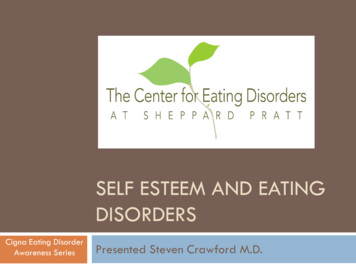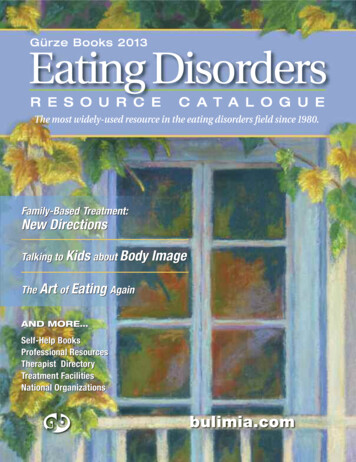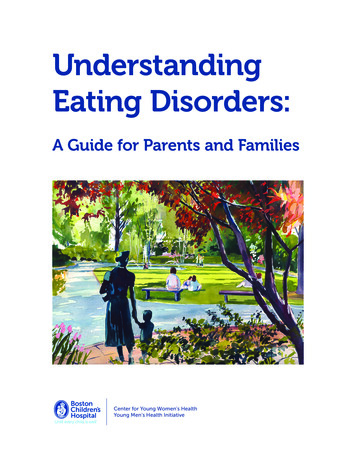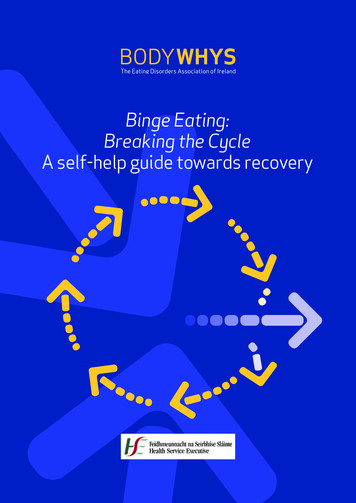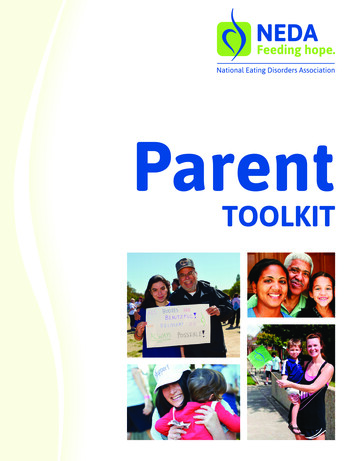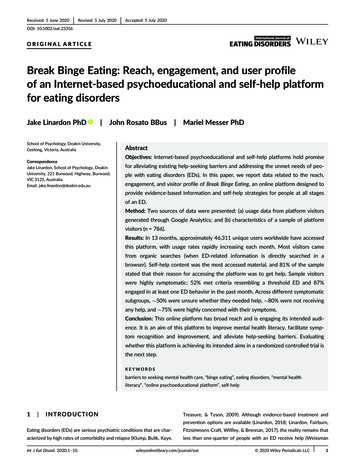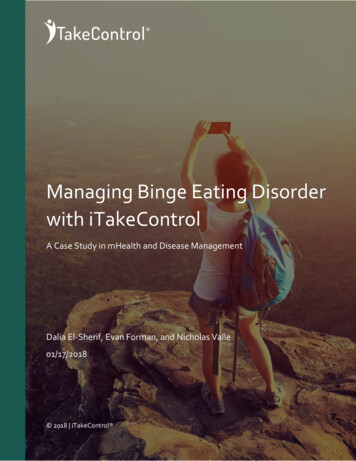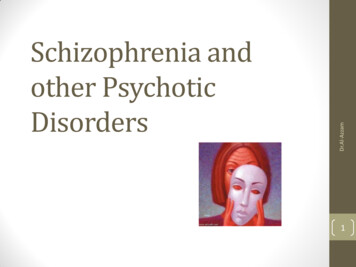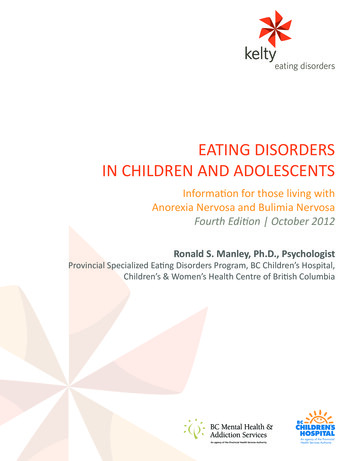
Transcription
eating disordersEATING DISORDERSIN CHILDREN AND ADOLESCENTSInformation for those living withAnorexia Nervosa and Bulimia NervosaFourth Edition October 2012Ronald S. Manley, Ph.D., PsychologistProvincial Specialized Eating Disorders Program, BC Children’s Hospital,Children’s & Women’s Health Centre of British Columbia
Table of ContentsWhat Are Eating Disorders? 3Anorexia Nervosa 3Bulimia Nervosa 4Eating Disorder Not Otherwise Specified 4Why Eating Disorders are Serious Problems 5What Causes These Eating Disorders? 5Some Things to Consider 6For the Youth 6For Your Family 7Your Thoughts and Feelings 8Seeking Help 8What Does Treatment Involve? 9The Process of Recovery 9eating disFurther Resources 10For Further Information 10Fourth edition updated by BC Mental Health & Addiction Services
Information for Those Living with Anorexia Nervosa and Bulimia Nervosa Fourth Editionkelty eating disorderseating disordWhat Are EatingDisorders?Eating disorders are very complex illnesses.Many things contribute to their development.The media makes thinness look glamorousand desirable, but people do not developeating disorders because they are trying to getattention or look like fashion models.Eating disorders can have very serious andharmful effects on young people and theirfamilies. Youth with eating disorders are oftenlonely and terrified. Families often don’t knowwhat to do. There may be a delay between thestart of an eating disorder and a decision to lookfor help. The person with the problem may feelmore and more isolated. She may think thatothers cannot understand or help her.This booklet provides information on eatingdisorders in children and youth. It also offerssome suggestions for coping during difficulttimes and finding help. The booklet refers tothose struggling with an eating disorder as“she.” However, it is important to point out thatboys and young men can also develop eatingdisorders that are serious and may be lifethreatening.Doctors refer to three eating disorders: Anorexia Nervosa Bulimia Nervosa EDNOS (eating disorder not otherwisespecified)Anorexia NervosaThere are two types of anorexia nervosa:1 The first is a “restricting” type of eatingdisorder. A person with this type ofanorexia nervosa:Is below normal weight and usually hason-going weight loss because she restrictsfood intake.May overexercise to burn off unwantedcalories.Usually is preoccupied with food and thinksconstantly about eating and calories. Maycook for others.Can develop rituals around food and eatinglike cutting food into tiny pieces and taking along time to eat.Often has a body image disturbance. Shefeels fat and may see herself this way evenwhen she is very thin.Usually has unrealistic thinking patterns.“Everything will be okay just as long asI am thin.” Thinking may be extreme,perfectionistic or “all-or-nothing.” Forexample, she may think that anything lessthan 90% on a test is a sign of failure.sorders2The second type of anorexia nervosa isthe “binge eating and/or purging” type.It is the same as the first type, but also includesbinge eating or purging, or both. Binging iseating a large amount of food very quickly andusually in secret. People often say they feel outof control or like they are in a trance when theybinge. People purge to avoid gaining weight fromunwanted food or the effects of eating. Someforms of purging are self-induced vomiting andoverexercising.3
kelty eating disordersEating Disorders in Children and Adolescentseating disordersDiagnosis of anorexia nervosaBulimia nervosaAn adult who does “not maintain a minimallynormal weight for age and height” can bediagnosed with anorexia nervosa. Not everythin person has this illness, but someone doesnot have to be extremely skinny to suffer fromanorexia nervosa.The main feature of this eating disorder isregular binge eating followed by efforts tocompensate for, or prevent possible weight gain.A person with bulimia nervosa: Feels a loss of control over eating and fearsshe won’t be able to stop. May attempt to avoid weight gain throughpurging behaviours such as vigorous exerciseor fasting. Is usually within an average weight range,although weight may fluctuate widelyover time.Eating disorder not otherwise specified(EDNOS)Doctors use EDNOS as a diagnosis when all thecriteria for anorexia nervosa or bulimia nervosaare not present. For example, an individualmay purge after eating but not binge eat. Mostpeople who seek treatment are diagnosed withEDNOS because their symptoms do not fit nicelyinto either the anorexia nervosa or bulimianervosa categories. This disorder, however, isevery bit as serious as anorexia nervosa andbulimia nervosa.More facts about anorexia nervosa»» Up to 50% of those with anorexia nervosa willbinge and purge.»» About 1 in 200 female youth develop anorexianervosa.»» It usually develops during the adolescent years.This may be partly because young people are veryself-conscious about their bodies. Also, there aremany pressures to be thin in our society especiallyfor females.»» There are a number of reports on anorexia nervosain the 8–14 year old age range. In many instances itoccurs before the child has undergone puberty.4More facts about bulimia nervosa»» About 1–3% of female adolescents and youngwomen struggle with bulimia nervosa.»» It usually occurs in mid- to late adolescence and inyoung adults.»» Bulimia nervosa can occur in very early adolescence.Males and anorexia nervosa90% of those with anorexia nervosa are female. Thatmay change as the media focuses more on the bodyshape of young males and men. Females continue toface extreme pressures to be thin and are bombardedwith negative body image messages each and every day.
Information for Those Living with Anorexia Nervosa and Bulimia Nervosa Fourth Editionkelty eating disorderseating disordWhy Eating Disordersare Serious ProblemsWhat Causes TheseEating Disorders?You may not notice the effects of an eatingdisorder immediately, but they can do seriouslong term damage. It is important to get help asearly as possible. The effects may be very hardor impossible to reverse. They may include: Irregular periods or loss of menstruationwith much difficulty getting back to normal.This may have a long term impact on theability to get pregnant. Dizziness, lack of energy, and malaise (ageneral feeling of unwellness), as a result oflow blood pressure and/or dehydration.Many things contribute to the development ofan eating disorder:Individual factorsThe young person at risk is often a perfectionistand has felt “not good enough” for a long time.She has low self-esteem and self-doubt. She maynot know the best weight range for herself andmay use weight “numbers” to measure how shefeels about herself. She is sensitive to the needsof others, but has difficulty seeing and talkingabout her own needs and feelings.Family factorsFamilies do not causeeating disorders.However, the ways familymembers communicatecan be a contributingfactor. As a family triesto cope with an eatingdisorder, communicationmay become tense andexplosive.Cultural factors Weak bones. Signs of starvation—dry skin, feeling cold,loss of hair, depression, anxiety, problemsconcentrating, etc. A delay in growth or possible stunting ofgrowth in children and adolescents. Tooth decay, tooth loss, and gum disease asa result of repeated vomiting. Electrolyte disturbances—this is a change inthose substances which help our bodies towork properly. For example, low potassiumlevels can lead to problems with the heart,nervous system, and muscles. A high risk of heart irregularities which cancause death Negative feelings about self—depressed,hopeless, not good enough. Thoughts about suicide or self-harm insome people.These factors includethe many pressures that women and men facein our society. For example, we expect womento be attractive and assertive. We encouragethem to find careers and at the same time to be“super-moms.” And all around us, the messageon magazine covers, in movies, on TV, and onbillboards is “thin is beautiful.” So, it is notunusual for a young woman to wish to be thinand to decide to lose weight. At first, friends andfamily may encourage and support dieting. But,dieting can lead to a serious eating disorder in ayoung person with other risk factors.5
kelty eating disordersEating Disorders in Children and Adolescentseating disordersSome Things to ConsiderFor the Youth1. It is important to realize that someone withan eating disorder often thinks and feelsthat nothing is wrong. Even though youfeel anxious about gaining weight and youwant to keep losing weight, you may not seethis as a problem. It takes a great deal ofcourage to seek help and develop a workingrelationship with a counsellor or therapist.Getting help does not have to mean a lossof control.4. Binge eating and purging are not diseases.They are behaviours that can change.Many things can contribute to a binge,including dieting and feeling lonely, angryor inadequate. When binging is followed bypurging, it can be more serious and moreupsetting for you. You may feel helpless andhopeless. It is very important to realize thatyou are not at fault; these behaviours areways of coping with how you feel.5. It can be very helpful to ask why our societyputs pressure on us to be thin. Body shapes inmagazines, movies and on TV are often veryunrealistic and can damage feelings of selfesteem. Try to examine these media messagesand decide for yourself what is “real.”6. If you are an older youth, check out theself-help groups that you might wish toattend. These groups can help you to feelless isolated and that “you must go throughthis alone.” They can provide valuableinformation and help in getting treatment.2. You may not be able to overcome theseproblems on your own, but you can get helpand you can overcome an eating disorder. Itis normal to feel discouraged and doubt thatanyone can understand your experience. Aneating disorder can be devastating. It is easyto be confused by the different thoughts andfeelings that you have. However, there areothers who understand what you have beengoing through.3. Your body has been going without foodfor some time. This can cause many of thesymptoms of an eating disorder. Your bodydoes not know the reason you are noteating, and it reacts by showing symptomsof starvation. These include physical effectslike drying skin, hair loss. They also includepsychological effects such as feeling irritableor depressed. Once you have reached a stateof starvation, it is difficult to reverse onyour own.67. Many people with an eating disorder saythey feel like there are two parts to them.One part may desperately want help, but theeating disorder part, tries to stop them fromlooking for help or treatment. You probablyhave mixed feelings, too. This is called“ambivalence” and it is very common. Youmay be afraid of losing a part of yourself thatin some ways has felt like a “friend” that hashelped you to cope with life. But, you mustfind ways to support and strengthen the partof yourself that wants to get better and havea life free from an eating disorder. Talk toyour family doctor or to a school counselorthat you trust. Describe how you arefeeling. Think about asking a friend or familymember to go with you to appointments andsupport you during treatment.
Information for Those Living with Anorexia Nervosa and Bulimia Nervosa Fourth Editionkelty eating disorderseating disordFor Your Family1. If you think someone in your family may haveor may be developing an eating disorder, itis important to get professional help. A goodplace to start is with your family doctor. Ifneeded, your doctor can make a referral formore specialized evaluation and treatment.2. Families often go through several stages astheir child loses weight. At first, they maynotice some weight loss. As time goes on,they develop concern, anxiety, fear, and evendisbelief at how much weight the child haslost. It is important to seek help as early aspossible. Dieting that is ongoing and chroniccan have serious consequences. Do notregard the signs and symptoms as “a stageshe’ll grow out of.” They are a signal to lookfor help as soon as possible.3. If your daughter or son has an eatingdisorder, do not get caught up in self-blame.Family issues may play a part in the disorder,but feelings of self-blame do not help therecovery process. And, do not blame yourchild; it may cause more harm to her feelingsabout herself. Try to separate the personfrom the problem, the eating disorder. Focuson supporting her efforts to recover. Whena child or adolescent develops an eatingdisorder, it is crucial that parents worktogether even if they are separatedor divorced.5. If you have a daughter with an eatingdisorder, you have probably tried manyways to encourage her to eat. You mayhave had bitter arguments at the dinnertable and tried begging and even threats.It is important to realize that your child isterrified to gain weight. It will not be easyfor her to undertake recovery and let go ofthe eating disorder. It can feel like a greatrisk and may mean facing tremendous fears.However, there is a strong role that you asa parent(s) can play in your child’s recovery.Your treatment team can coach you on thebest way to manage these issues at home.6. Many parents find it very helpful to meetother parents who have gone throughsimilar experiences. Look into the possibilityof joining or starting a support group forparents in your community. Peer counselingmay be available. The agencies listed at theend of this booklet are a place to start.4. It is very upsetting for a family to be facedwith a daughter or son who is unable toeat. It is normal to feel frustrated, hopeless,angry, afraid, and guilty. When familymembers recognize and admit to thesefeelings, they are more likely to get help. Itis important to discuss these feelings with ahealth care professional.7
kelty eating disordersEating Disorders in Children and Adolescentseating disordersYour Thoughtsand FeelingsSeeking HelpA person with an eating disorder often hasunrealistic thoughts and attitudes, for example: “If I start to eat more, I’ll lose control andget fat.” “If I don’t lose another five pounds, I’llnever be happy.” “I’ll always be depressed and lonely. No oneunderstands what this is like.” “No one really likes me.” “I have to be the sickest person with aneating disorder in order to justifygetting help.”It is important to find treatment you feelcomfortable with and can trust. Part of thistrust is based on working with health careprofessionals who understand your experiences.You will need to feel that you can work togetheron a variety of concerns and issues. These willinclude weight gain and preoccupations withfood. Remember that it is not you against them,but rather, you, your family, and the treatmentteam against the eating disorder.As an eating disorder develops,your thoughts are more and moreabout food, eating, weight, shape,self-doubt, and helplessness.These kinds of thoughts can havea deep effect on the way youfeel. It is important to learn howthese thoughts and feelings havecontributed to your eating disorder.As part of the recovery process, youwill learn other ways of thinkingand feeling about yourself. It willalso be important to gain weight ifnecessary and learn normal ways tobehave around eating.8
Information for Those Living with Anorexia Nervosa and Bulimia Nervosa Fourth Editionkelty eating disorderseating disordWhat DoesTreatment Involve?The Process of RecoveryA team of health care professionals will beresponsible for your treatment. All the membersof the team are experienced in assessing andtreating children and adolescents with eatingdisorders. We know there are differencesbetween young people and adults with eatingdisorders so experience with this age group isvery important. Treatment is designed with theage and needs of each child or youth. It is basedon a biopsychosocial model. This will includemedical and nutritional counseling. A physicianwill regularly check your physical condition.There will be follow-up and attention to yourpsychological, social, school, and spiritual needs.Many things contribute to recovery from aneating disorder. One key factor is learning tocare for and nurture oneself. For example, itmay be helpful to keep a journal, read materialwith a positive message, or do something justfor pleasure.You will have one-to-one sessions with atherapist or counsellor. There are many kinds ofpsychotherapy that could be useful. One typeof therapy called cognitive-behavioural therapyhas been very helpful for the bulimia nervosatype of eating disorder. This therapy focuseson thoughts, feelings, and behaviours, and therelationships between them.It is important for the family to keep an openmind towards parental counselling, familytherapy, or marital therapy. One or more ofthese therapies will likely be a valuable part ofthe overall treatment plan. Family-based therapyis the best treatment for younger adolescentswith anorexia nervosa. In the beginning, it willfocus on showing parents how to safely andsuccessfully help their child to eat. One kind oftherapy—Multiple Family Day Therapy—involvesa number of families meeting together withtherapists over several days of treatment. Itincludes follow-up sessions for a numberof months.A good therapist will be objective and not blameanyone in any of these types of therapy sessions.Instead, the therapist will help families to explorepositive ways to communicate and interact.It is important to recognize that it takes timeto get better. There will be ups and downs.Recovery is a step-by-step process of taking risks.There will be some difficult times. Sometimesyou may slip and think that means you arenot making progress. However, this is part ofrecovery and may in fact mean that you aregetting ready to take the next forward step. It isbest to see these difficult times as a chance tolearn more about yourself. Remember that theprocess and timetable for each person’s recoveryis different and will depend upon you and yourfamily’s unique needs.9
kelty eating disordersEating Disorders in Children and Adolescentseating disordersFurther ResourcesFor Further InformationNational Eating Disorders Association(NEDA) – Parent ToolkitKelty Mental Health Resource esources/parent-toolkit.phpThis toolkit is for anyone wanting to understandmore about eating disorders and how to supporta family member or friend who’s affected.Meal Support Videotinyurl.com/mealsupport-videoThis video demonstrates strategies that familiescan use before, during and after meals toprovide structure and support for youth witheating disorders.604-875-2084 (Toll Free: 1-800-665-1822)keltymentalhealth.ca or e Kelty Mental Health Resource Centre isBC’s information source for children, youthand families dealing with mental health andsubstance use issues. In addition, the Centreoffers resources on eating disorders for all ages.Peer support is available for youth, parentsand those struggling with eating disorders.For further information you are welcometo call, visit or send an email to the Centreat keltycentre@bcmhs.bc.ca. Visit the KeltyYouTube channel for educational videos oneating disorders and other areas of mentalhealth and substance use.Jessie’s Legacy Eating DisordersPrevention Program, Family Services ofthe North ShoreBooks Brave Girl Eating by Harriet Brown (2010) Help your Teenager Beat an Eating Disorderby James Lock & Daniel Le Grange (2005) A Parent’s Guide to Defeating EatingDisorders: Spotting the Stealth Bomberand Other Symbolic Approaches by AhmedBoachie and Karin Jasper (2011) Feeding Your Anorexic Adolescent by ClaireNorton (2009) Goodbye Ed, Hello Me by Jennifer Schaefer(2009)BC Children’s Hospital Family ResourceLibrary – Eating Disorders sorders%20Bibliography%20Sep08.pdf604-453-8335 (Toll Free: 1-800-331-1533)Email: FSRC@cw.bc.ca604-988-5281 ext. 204 or /jessies-legacyThe Jessie’s Legacy Eating Disorders PreventionProgram provides media watch, on-line andtelephone support, psycho-education groupsfor parents, an Eating Disorder Support Groupfor Parents, Partners and Friends, and one-toone brief counselling.Looking Glass Foundation for EatingDisorders604-904-2226 or www.lookingglassbc.comAn organization formed by parents, friends andindividuals who have lived experience of havinga child suffering from an eating disorder. Onlinesupport groups are offered for adolescents andadults with eating disorders and their familyor friends.National Eating Disorder InformationCentre (NEDIC)www.nedic.caProvides information, resources and a Canadiandirectory on eating disorders, offers self-helpand prevention tips for family and friends of allages struggling with eating disorders.
Noteseating disordAdditional copies of this booklet may be purchasedby writing to the Provincial Specialized EatingDisorders Program, BC Children’s Hospital, MentalHealth Building, 4500 Oak Street, Vancouver, BC,V6H 3N1.The author wishes to thank Connie Coniglio, Ed.D.,for her helpful comments and suggestions on anearlier draft of this booklet.About the AuthorDr. Manley received his Ph.D. degree in clinicalpsychology from Queen’s University, and hasbeen working as a psychologist in the field ofeating disorders for over twenty-seven years at BCChildren’s Hospital. He is also a Clinical AssistantProfessor in the Department of Psychiatry at theUniversity of British Columbia. He has co-developedthe Perceived Body Image Scale, a tool for assessingbody image in women, and has conductednumerous workshops on eating disorders. Hisclinical work currently includes consultation andpsychotherapy. Dr. Manley is a registered weighttraining instructor, personal trainer, and yogafitness instructor. He has a particular interest inthe treatment of recreational and elite athleteswith eating disorders, as well as in the treatmentof trauma.
RM/April/2010eating disorders
The main feature of this eating disorder is regular binge eating followed by efforts to compensate for, or prevent possible weight gain. A person with bulimia nervosa: Feels a loss of control over eating and fears she won’t be able to stop. May attempt to avoid weight gain through
